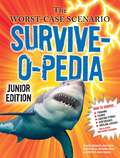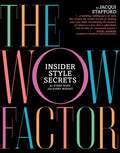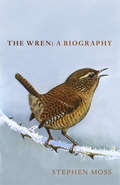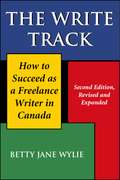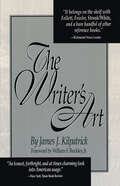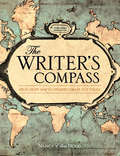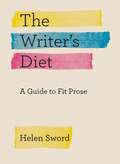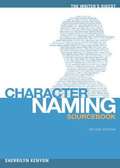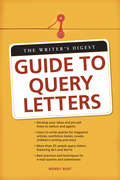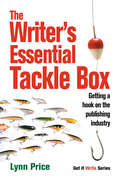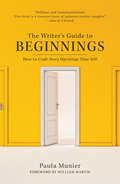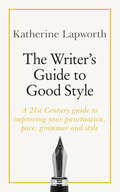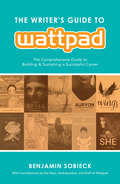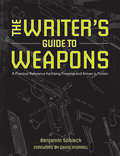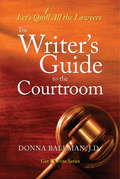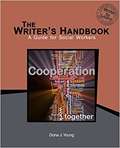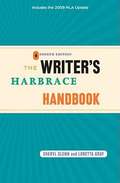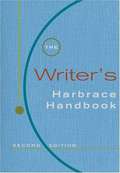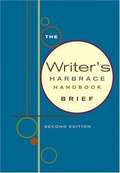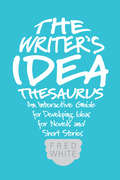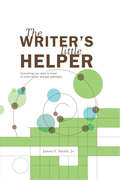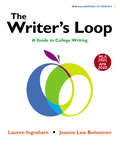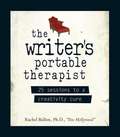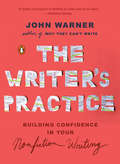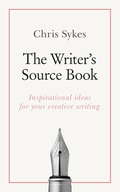- Table View
- List View
The Worst-Case Scenario Survive-o-pedia: Junior Edition
by David Borgenicht Robin EpsteinIt's the best of the worst! This edition of the popular series loved by parents and kids alike serves up a wild ride through mudslides, volcanoes, shark-infested oceans, menacing mountains, and more. Seventy entries are packed with illuminating facts, eye-popping photos, hilarious illustrations, must-see maps, heaps of humor, and step-by-step instructions. Readers will be armed with the knowledge and skills needed to survive anything and live to tell about it!
The Wow Factor: Insider Style Secrets for Every Body and Every Budget
by Jacqui StaffordFashion editor and style expert Jacqui Stafford&’s new fashion bible proves that you don&’t have to be skinny or rich to look and feel fabulous. Some women just have "it". That indefinable something that makes them look effortlessly stylish, pulled together, and WOW! But if you think they were born with it, think again. You see, any woman can be a knockout - with a little help from Jacqui. In her fabulous new style bible, fashion editor and world-renowned style expert Jacqui Stafford is spilling all her insider secrets. An unpretentious, totally accessible guide, The Wow Factor reveals all the tricks that fashion and beauty editors use to make celebs and models look picture perfect. She'll share industry tips for the hair, makeup and clothing that makes you the best version of YOU possible. (Hint: It's got nothing to do with being rich or skinny.)With her signature cheeky British humor, Jacqui takes the mystery out of: How to figure out your body shape to create your ideal body (Are you a Cocktail Ring or Sunglasses? A Fragrance Bottle or Lipstick?) How to make the plainest outfit dazzle with the right accessories What are the definitive beauty and skincare products that really get results (and why you can forget the rest) Where, and why, fashion editors shop when they do How to follow hard-to-wear fashion trends (and which trends to ignore) Why some women look super wealthy (even if they're not) And much, much more.
The Wren: A Biography (The Bird Biography Series #2)
by Stephen MossFrom the bestselling author of The Robin: A Biography, Stephan Moss:The wren is a paradox of a bird. They are Britain's most common bird, with 8.5 million breeding pairs and have by far the loudest song in proportion to their size. They also thrive up and down Britain and Ireland: from the smallest city garden to remote offshore islands, blustery moors to chilly mountains. Yet many people are not sure if they have ever seen a wren. Perhaps because the wren is so tiny, weighing just as much as two A4 sheets of paper, and so busy, always on the move, more mouse than bird.However if we cast our eyes back to recent history wrens were a mainstay of literary, cultural and popular history. The wren was on postage stamps and the farthing, it featured in nursery rhymes and greetings cards, poems and rural 'wren hunts', still a recent memory in Ireland particularly.With beautiful illustrations throughout, this captivating year-in-the-life biography reveals the hidden secrets of this fascinating bird that lives right on our doorstep.
The Write Track: How to Succeed as a Freelance Writer in Canada Second Edition, Revised and Expanded
by Betty Jane WylieThe Write Track is a personal and practical look at the author’s freelance experience as she tells how she made it from uncertain early days to the growing confidence of a veteran. This guide is packed with the information a freelance writer needs to know, including: a writer’s self-evaluation profits from brainwaves details of the writing life and the writing business a writer’s rights and responsibilities and those important "first steps" into the freelance world If you want to make a living as a freelance writer in Canada, you need to read The Write Track.
The Writer's Art
by James J. Kilpatrick“A witty, entertaining, and enlightening antidote to sloppy, inflated, vague, or dull prose.” —Publishers WeeklyWriting comes in grades of quality in the fashion of beer and baseball games—good, better, and best. With the experience of a lifetime spent writing, James J. Kilpatrick wants to make a few judgment calls. Here, in the great tradition of Theodore Bernstein, Edwin Newman, and William Safire, a master of the art gives us a finely crafted, witty guide to writing well. Intended for laymen and professionals alike, The Writer’s Art highlights techniques and examples of good writing—and a section of the book called “My Crotchets and Your Crotchets” comprises more than two hundred personal judgment calls, often controversial, often funny, on word usage.“Put it on your shelf between Strunk & White’s Elements of Style and William Zinsser’s On Writing Well.” —Cleveland Plain Dealer“An honest, forthright, and at times charming look into American usage.” —The New York Times Book Review“The Writer’s Art is itself a work of art.” —Dallas Morning News
The Writer's Compass: From Story Map to Finished Draft in 7 Stages
by Nancy Ellen DoddMap out your idea and finish your story in 7 stages! This book will show writers how to develop their ideas into a finished novel by working through it in 7 stages, while learning how to mapping out their story's progress and structure so they can evaluate and improve their work. It teaches writers to visualize their story's progress with a story map that helps them see all the different components of their story, where these components are going, and, perhaps most importantly, what's missing. The book simplifies Aristotle's elements of good writing (a. k. a. that each story should have a beginning, a middle and an end) into easily applicable concepts that will help writers improve their craft. The author helps readers strengthen their work by teaching them how to focus on one aspect of their story at a time, including forming stories and developing ideas, building strong structures, creating vibrant characters, and structuring scenes and transitions. Thought-provoking questions help writers more objectively assess their story's strengths and weaknesses so they may write the story they want to tell.
The Writer's Diet: A Guide to Fit Prose (Chicago Guides to Writing, Editing, and Publishing)
by Helen SwordDo your sentences sag? Could your paragraphs use a pick-me-up? If so, The Writer's Diet is for you! It's a short, sharp introduction to great writing that will help you energize your prose and boost your verbal fitness. Helen Sword dispenses with excessive explanations and overwrought analysis. Instead, she offers an easy-to-follow set of writing principles: use active verbs whenever possible; favor concrete language over vague abstractions; avoid long strings of prepositional phrases; employ adjectives and adverbs only when they contribute something new to the meaning of a sentence; and reduce your dependence on four pernicious "waste words": it, this, that, and there. Sword then shows the rules in action through examples from William Shakespeare, Emily Dickinson, Martin Luther King Jr. , John McPhee, A. S. Byatt, Richard Dawkins, Alison Gopnik, and many more. A writing fitness test encourages you to assess your own writing and get immediate advice on addressing problem areas. While The Writer's Diet is as sleek and concise as the writing ideals contained within, this slim volume packs a powerful punch. With Sword's coaching writers of all levels can strengthen and tone their sentences with the stroke of a pen or the click of a mouse. As with any fitness routine, adhering to the rules requires energy and vigilance. The results, however, will speak for themselves.
The Writer's Digest Character Naming Sourcebook
by Sherrilyn KenyonThis reference for writers provides meanings for some 25,000 names and surnames from 45 countries, listed by origin. An explanation of naming practices and historical context is provided for each origin section, and there is a reverse lookup of names by meaning, as well as an alphabetical index of names. An introduction gives practical advice on naming characters and places plus tips on naming for specific genres, and sidebars within the entry sections tell how published authors solved their naming dilemmas. Kenyon (whose name means Blond from the White Meadow) is a fantasy author. Annotation ©2006 Book News, Inc., Portland, OR (booknews.com)
The Writer's Digest: Guide to Query Letters
by Wendy Burt-ThomasMake That Crucial, Positive First Impression Anyone who's researched the marketplace knows: The path to publication begins with your query letter. If your query is weak, unfocused, or uninspired, an editor or agent won't even bother to request your article, novel manuscript, or nonfiction book proposal. But a well-crafted, compelling query sent to the right editor or agent is an essential sales tool for fiction writers and the most effective way for nonfiction writers to pre-sell your idea. In this book, professional freelance writer and magazine editor Wendy Burt-Thomas shares practical advice on how to craft persuasive letters that connect with editors and agents and ultimately generate sales for you. You'll learn how to: Conduct targeted research to find suitable editors and agents Hook an editor with a tantalizing lead and shape a summary that compels editors to buy Select the strongest slant for your book or article Use research and interview shortcuts that keep your query prep profitable Make your query rejection-proof by weeding out subtle mistakes that can sabotage your project Communicate your author platform and sell yourself as the best writer for the subject Complete with dozens of sample queries–some that landed article assignments, agents, or book deals, and others that never stood a chance–this book offers you a comprehensive strategy for presenting your writing ideas in a way that will increase your chances of publication. Though the title may lead some to believe it's strictly to be shelved as a reference manual,The Writer's Digest Guide to Query Lettersis a smooth read from cover to cover.
The Writer's Essential Tackle Box
by Lynn PriceThe Writer's Essential Tackle Box offers an insider's view that informs and educates writers to key occupations that comprise the publishing industry--how they work, why they work, and pitfalls to avoid. A must-read for the new author seeking guidance through every aspect of the murky waters of publishing.
The Writer's Guide to Beginnings: How to Craft Story Openings That Sell
by William Martin Paula MunierGive your story its best start! The best beginnings possess a magical quality that grabs readers from the first word and never lets them go. But beginnings aren't just the door into a fictional world. They are the gateway to the realm of publishing--one that could shut as quickly as it opens. In The Writer's Guide to Beginnings, author and literary agent Paula Munier shows you how to craft flawless beginnings that impress agents, engage editors, and captivate readers. You'll learn how to develop the big idea of your story and introduce it on page one, structure opening scenes that encompass their own story arc, kickstart your writing with effective brainstorming techniques, and introduce a compelling cast of characters that drive the plot. You'll also examine the best-selling novels from different genres to learn the secrets that experienced writers use to dive straight into a story. With thorough examinations of voice, point of view, setting, dialogue and conflict, The Writer's Guide to Beginnings is a must-have tool for luring your readers in with your opening pages--and convincing them to stick around for the ride. "Writing a book? Hard. Writing the beginning of a book? Rocket science! Strap on your spacesuit, because thanks to Munier's nuanced, actionable breakdown of every possible aspect of a gripping opening, authors everywhere can now take their books to the stars." --K.M. Weiland
The Writer's Guide to Good Style: A 21st Century guide to improving your punctuation, pace, grammar and style
by Katherine LapworthLEARN HOW TO LIFT YOUR CREATIVE WRITING BY EMPLOYING A GOOD WRITING STYLE.Do you want to write more effectively, correctly and in a manner which is appropriate for this brave new world of text speak and blogging?Whether you are a professional writer, or writing for your profession, a journalist, non-fiction writer, or simply a would-be blogger, you will find essential guidance and the latest style rules in this book.It contains firstly a detailed breakdown of both the rules of grammar, punctuation and spelling and, secondly, a guide to making your work readable, structured and well-paced. Unlike any other style guide, it also sets out the new and evolving rules for 21st century writing such as blogging, chatrooms, and even PowerPoint presentations.ABOUT THE SERIESThe Teach Yourself Creative Writing series helps aspiring authors tell their story. Covering a range of genres from science fiction and romantic novels, to illustrated children's books and comedy, this series is packed with advice, exercises and tips for unlocking creativity and improving your writing. And because we know how daunting the blank page can be, we set up the Just Write online community at tyjustwrite, for budding authors and successful writers to connect and share.
The Writer's Guide to Wattpad: The Comprehensive Guide to Building and Sustaining a Successful Career
by Benjamin Sobieck Wattpad WattpadEngage with the Next Generation of Writers! Wattpad is an online storytelling community where users can post their writing, such as articles, stories, novels, fan fiction, and poems. This platform offers writers the chance to connect directly with readers, fans, and story enthusiasts. With the ability to release stories and chapters one at a time, authors can receive continual encouragement and real-time feedback on their work. The Wattpad staff supports successful writers through their Stars program, which provides them opportunities to work with successful brands, publish to print, connect to film and television industries, and more. The potential of Wattpad for writers is limitless, and, for the first-time ever, the staff, writers, and stars of Wattpad have created the guide to help you launch and sustain a successful writing career through this platform. In The Writer's Guide to Wattpad, you'll learn how to:Get started using Wattpad, prepare your writing to be published, and develop a unique cover design.Interact with readers, use multimedia to enhance and tell stories, and leverage social media to create a stronger platform.Attract the attention of an agent or publisher and sell copies of your work elsewhere.Tap into the brand of Wattpad to understand their Stars Program, brand campaigns, and what success looks like.Written to be accessible to beginners and veterans alike, The Writer's Guide to Wattpad is your essential companion to navigating the Wattpad platform and brand, and leveraging your writing to millions of users worldwide.
The Writer's Guide to Weapons: A Practical Reference for Using Firearms and Knives in Fiction
by Benjamin SobieckWhen it comes to writing weapons, most authors shoot from the hip--and miss. The Writer's Guide to Weapons will help you hit your target every time. Firearms and knives have starring roles in a wide range of genres--crime, thriller, war, mystery, Western, and more. Unfortunately, many depictions of weapons in novels and film are pure fiction. Knowing the difference between a shotshell and a slug, a pistol and a revolver, or a switchblade and a butterfly knife is essential for imbuing your story with authenticity--and gaining popularity with discerning readers. Inside you'll find: An in-depth look at the basics of firearms and knives: how they work, why they work, what they look like, and how to depict them accurately in your stories. The biggest weapons myths in fiction, TV, and film. A surefire guide for choosing the correct weapon for your characters, no matter their skill level, strength, or background. A review of major gun and knife laws, weapons safety tips,and common police tactics. "The Hit List," showcasing the most popular weapons for spies, detectives, gunslingers, gangsters, military characters, and more. Examples highlighting inaccurate vs. accurate weapons depictions. An insightful foreword by David Morrell, the award-winning creator of Rambo. Equal parts accessible, humorous, and practical, The Writer's Guide to Weapons is the one resource you need to incorporate firearms and knives into your fiction like a seasoned professional.
The Writer's Guide to the Courtroom
by Donna BallmanOne-stop shopping for researching the complexities of all aspects of civil law. Whether one writes mysteries, romance, mainstream, or nonfiction, if the facts are wrong, the book is ruined. Adding some element of the law is also a valuable asset for adding further dimension or a plot twist to a story.
The Writer's Handbook: A Guide For Social Workers
by Dona Young Andrea Tamburro Marshelia HarrisThe Writer's Handbook: A Guide for Social Workers is a writing reference for social work majors and graduate students. Specific to social work, the text contains chapters on documenting in the field, research, and APA style citation and formatting. In addition, learners have access to full chapters on principles of grammar (such as verbs, pronouns, and parallel structure), punctuation (commas, semicolons, colons, quotation marks, and so on), and writing style (active voice, conciseness).The text is designed to help writers at all levels bring the quality of their work to higher levels by reviewing principles followed by practice.Since APA style is required for social work study, a special effort has been make to present a full chapter on APA style as well as integrate APA requirements in formatting and style throughout the text.The text is reader friendly, contains keys to all exercises at the back of the book, and gives learners access to interactive activities at the book's website.
The Writer's Harbrace Handbook
by Cheryl Glenn Loretta GrayTHE WRITER'S HARBRACE HANDBOOK, 4th Edition, is grounded in the belief that an understanding of the rhetorical situation--the writer, reader, message, context, and exigence (reason for writing)--provides the best starting point for effective writing and reading. This comprehensive handbook guides student writers in employing that rhetorical understanding as they choose the most effective information to include, the best arrangement of that information, and the most appropriate language to use. The text moves students through the steps that constitute successful writing--from finding appropriate topics and writing clear thesis statements to arranging ideas and developing initial drafts. THE WRITER'S HARBRACE HANDBOOK also provides several sample student papers and excerpts of papers in various disciplines, along with instruction for successfully completing similar assignments.
The Writer's Harbrace Handbook (2nd Edition)
by Cheryl Glenn Loretta Gray Suzanne Strobeck Webb Robert Keith MillerThe second edition of this handbook for college students maintains its focus on the rhetorical demands of writing and its emphasis on writing in the disciplines.
The Writer's Harbrace Handbook (Brief 2nd Edition)
by Cheryl Glenn Loretta Gray Robert K. Miller Suzanne Strobeck WebbProviding a reliable standard for writing students and teachers, this text is based on the Harbrace Handbook of English (1941), the perennial college grammar and writing guide that grew from a systematic analysis of errors in some 20,000 college papers. In addition to a cleaner and clearer design, the second edition offers new emphasis on the rhetorical situation; revamped chapters on drafting and revising essays, e-designing, and writing arguments; new chapters on e-writing and evaluating online and print sources; coverage of writing for academic discourse, social and natural sciences, and business; and expanded style guides for researched writing. Annotation (c)2003 Book News, Inc. , Portland, OR (booknews. com)
The Writer's Idea Thesaurus: An Interactive Guide for Developing Ideas for Novels and Short Stories
by Fred WhiteEndless ideas at your fingertips, and at the turn of a page... Need an idea for a short story or novel? Look no further than The Writer's Idea Thesaurus. It's far more than a collection of simple writing prompts. You'll find a vast treasury of story ideas inside, organized by subject, theme, and situation categories, and listed alphabetically for easy reference. Author and award-winning writing instructor Fred White shows you how to build out and customize these ideas to create unique plots that reflect your personal storytelling sensibilities, making The Writer's Idea Thesaurus an invaluable tool for generating creative ideas and vanquishing writer's block--for good. Inside you'll find: 2,000 unique and dynamic story ideas perfect for novels and short stories of any genre or writing style Twenty major idea categories, such as The Invasion of X, The Transformation of X into Y, Escape from X, The Curse of X, and more Multiple situations that further refine the major categories, such as The Creation of Artificial Life, The Descent Into Madness, Love in the Workplace, The Journey to a Forgotten Realm, and more Invaluable advice on how to customize each idea. The Writer's Idea Thesaurus is an interactive story generator that opens the door to thousands of new story arcs and plotlines.
The Writer's Little Helper: Everything You Need to Know to Write Better and Get Published
by James V. SmithBig Fiction Advice from a Little Book There is nothing little about the dynamic fiction-writing advice insideThe Writer's Little Helper. With big ideas, time-saving tips, and revision-made-easy charts, James V. Smith, Jr. offers effective guidance in short, easily checklists, Q&As, and practical tools. This book gives you everything you need to: Create great characters Maintain a compelling pace Craft believable dialogue Expand your creativity Revise your work to perfection Attract agent's and editor's attention And much, much more! The unique format of the book allows you to read from start to finish or to focus just on areas where your fiction needs work. With valuable and surprising tips on every page,The Writer's Little Helperis sure to become your biggest fiction writing aid.
The Writer's Loop with 2020 APA and 2021 MLA Updates
by Lauren Ingraham Jeanne BohannonThis ebook has been updated to provide you with the latest guidance on documenting sources in MLA style and follows the guidelines set forth in the MLA Handbook, 9th edition (April 2021).The Writer’s Loop, presents a refreshing, practical approach to writing, based on the habits of strong writers, who pause often, reflect, and loop backwards and forwards as they revise on their way to a final draft. With integrated videos, relatable examples, clear explanations, and a consistent, scaffolded learning framework, each brief chapter engages writers through reflection and practices that support the most common types of academic writing, including essays, arguments, and research projectsAchieve with Ingraham and Bohannon, The Writer’s Loop combines instruction with integrated videos, powerful writing tools, and customizable multi-draft writing assignments.
The Writer's Portable Therapist
by Rachel BallonIn this inspiring, instructive little volume, noted therapist, author, and perfect muse Rachel "Doc Hollywood" Ballon, Ph. D. , sits on your shoulder whispering just the right thing at just the right time. Each chapter is a therapy session tackling a different aspect of the writing life-from conquering "page fright" and the perils/pleasures of solitude to tapping into your subconscious and nurturing the writer within. So, lie down on Dr. Rachel Ballon's couch, and send your creativity-and productivity-soaring! Book jacket.
The Writer's Practice: Building Confidence in Your Nonfiction Writing
by John WarnerFor anyone aiming to improve their skill as a writer, a revolutionary new approach to establishing robust writing practices inside and outside the classroomAfter a decade of teaching writing using the same methods he’d experienced as a student many years before, writer, editor, and educator John Warner realized he could do better. Drawing on his classroom experience and the most persuasive research in contemporary composition studies, he devised an innovative new framework: a step-by-step method that moves the student through a series of writing problems, an organic, bottom-up writing process that exposes and acculturates them to the ways writers work in the world. The time is right for this new and groundbreaking approach. The most popular books on composition take a formalistic view, utilizing “templates” in order to mimic the sorts of rhetorical moves academics make. While this is a valuable element of a writing education, there is room for something that speaks more broadly. The Writer’s Practice invites students and novice writers into an intellectually engaging, active learning process that prepares them for a wider range of academic and real-world writing and allows them to become invested and engaged in their own work.
The Writer's Source Book: Inspirational ideas for your creative writing
by Chris SykesLEARN NEW AND INSPIRING WAYS OF LIFTING YOUR CREATIVE WRITING.Is your creative writing in need of inspiration? Do you need confidence to create watertight plots and believable characters?The Writer's Source Book provides dozens of practical exercises to help you create storylines, craft people and generate ideas, with support and creative insight for every stage.It will give you support in identifying your genre and crafting your work around it, and help you to understand the complexities of plot and character before beginning to create your own.Inspired and inspiring exercises will help you master the structure of your book, story or play, while focused and innovative advise will help those who have run into trouble. This is a technical manual ideal for any writer who needs to build, fix, polish or perfect their storyline.ABOUT THE SERIESThe Teach Yourself Creative Writing series helps aspiring authors tell their story. Covering a range of genres from science fiction and romantic novels, to illustrated children's books and comedy, this series is packed with advice, exercises and tips for unlocking creativity and improving your writing. And because we know how daunting the blank page can be, we set up the Just Write online community at tyjustwrite, for budding authors and successful writers to connect and share.
